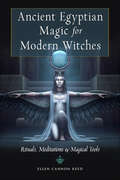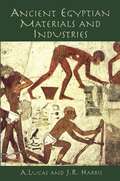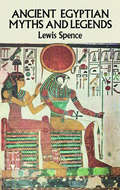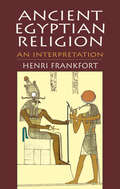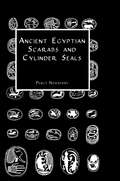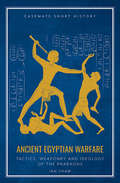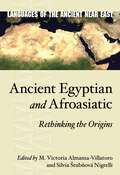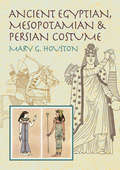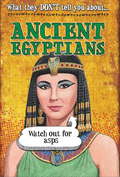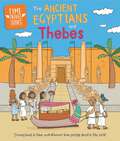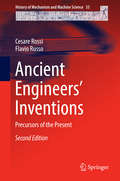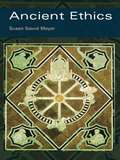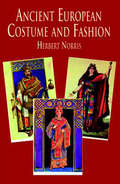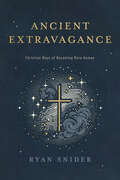- Table View
- List View
Ancient Egyptian Literature: A Book Of Readings
by Miriam LichtheimFirst published in 1973, this anthology has assumed classic status in the field of Egyptology and portrays the remarkable evolution of the literary forms of one of the world’s earliest civilizations. Beginning with the early and gradual evolution of Egyptian genres, it includes biographical and historical inscriptions carved on stone, the various classes of works written with pen on papyrus, and the mortuary literature that focuses on life after death. It then shows the culmination of these literary genres within the single period known as the New Kingdom (1550–1080 B.C.) and ends in the last millennium of Pharaonic civilization, from the tenth century B.C. to the beginning of the Christian era. An introduction written in three parts by Antonio Loprieno, Hans-W. Fischer-Elfert, and Joseph G. Manning completes this classic anthology.
Ancient Egyptian Magic
by Eleanor L. HarrisTakes readers through the fundamentals of Egyptian magic, its techniques, rituals, magical formulas.Ancient Egyptian Magic takes readers step by step through the Egyptian philosophy and practice of magic. The author, Eleanor L. Harris, is a long-time practitioner of Egyptian magic, and she explains the "hows" and "whys" of magical tools, amulets, rituals, ceremony, and spells. Advanced practitioners will find especially useful instruction on actual Egyptian magical script as found in the ancient papyri, such as The Leyden Papyrus, The Papyrus Ani (the Egyptian Book of the Dead), and other important works. You will learn how to: • Invoke Egyptian gods and spirits for divination and magic • Scry with fire, oil, and water • Evoke messengers and spirits of the dead • Have dream visions • Sound the secret names of the deities • Shape-shift into god forms • Cast spells for love, protection, and healing • Create ritual clothing and magical tools There is a glossary of deities and terms, along with a list of resources for more information on specialty items to outfit the detail-oriented magician.
Ancient Egyptian Magic for Modern Witches: Rituals, Meditations, and Magical Tools
by Ellen Cannon ReedRituals, prayers, and songs to bring the wisdom of the gods and goddesses of ancient Egypt to life.Based on Ellen Cannon Reed's twenty-five years of work with deities of ancient Egypt, this book brings an ancient tradition to modern pagan practice. With it, readers will have the tools to continue learning and developing their own methods of honoring the gods and goddesses of ancient Egypt.Over two dozen gods and goddesses are highlighted, including Osiris, Isis, Ra, Bast, Thoth, Sekhmet, and Tefnut. There is also a section devoted to glyphs. Finally, meditations and techniques bring these deities to life, enriching your spiritual path.The book provides a host of tools and techniques:•Songs for the deities•Rituals for ancient gods and goddesses•Instructions for making your own magical tools•Information about hieroglyphs•Guides to making incense and oils•Recipes for an ancient Egyptian feastPreviously published as Circle of Isis.
Ancient Egyptian Magic: A Hands-on Guide
by Christina RiggsAn entertaining and informative introduction to how ancient Egyptians practiced magic in their daily lives. In the ancient world, if you needed a love charm, wanted to contact your dead wife, or needed the ability to fly like a bird, the magicians of Egypt were the ones who could make it happen. In Ancient Egyptian Magic, Christina Riggs explores how the Egyptians thought about magic, who performed it and why, and also helps readers understand why we’ve come to think of ancient Egypt in such a mystical way. Readers will learn how to cure scorpion bites, discover why you might want to break the legs off your stuffed hippopotamus toy, and uncover whether mummies really can come back to life. Readers can also learn how to save a fortune on pregnancy tests—urinating on barley grains will answer that question— as well as how to use the next street parade to predict the future or ensure that an annoying neighbor gets his comeuppance. Was magic harmless fun, heartfelt hope, or something darker? Featuring demons, dream interpreters, the Book of the Dead, and illustrations from tomb paintings and papyrus scrolls, Riggs breathes new life into ancient magic and uses early texts and images to illuminate the distinctions between magic, religion, and medicine.
Ancient Egyptian Materials and Industries (Egypt)
by J. Harris A. LucasThe majesty and splendor of ancient Egypt were largely the result of the remarkably advanced technological skills developed by its artisans and craftsmen. This fascinating, comprehensive, and detailed study of ancient Egyptian technology meticulously describes the extent to which these workers and other Egyptians developed and used the land's vast resources.First published in 1926 and later revised and enlarged, this monumental work has become a standard reference, unparalleled in any other branch of archaeology. This volume reprints the fourth edition, painstakingly revised in light of more recent research and archaeological evidence.Among the subjects examined in the thoroughly documented text are the wealth of materials and processes that were an integral part of Egyptian daily life: the use of animal products, building materials, cosmetics, perfumes, and incense; fibers, glazed ware, glass and its manufacture; metals and alloys, painting materials, pottery making, woodworking, precious and semi-precious stones; distillation of alcoholic beverages; materials used in the mummification process, and much more.Enormously erudite, with an abundance of detailed information, Ancient Egyptian Materialsand Industries is an essential reference, valuable to students of Egyptology and classical civilizations and of vital interest to anyone intrigued by the long and remarkable history of technological development.
Ancient Egyptian Myths and Legends
by Lewis Spence"Let us walk in the gloom of the pyramids, in the cool shadows of ruined temples, aye, through the tortuous labyrinth of the Egyptian mind itself, trusting that by virtue of the light we carry we shall succeed in unravelling to some extent the age-long enigma of this mystic land." — from Chapter One.In this classic study, a noted mythologist made perhaps the first serious attempt to review the religious history of ancient Egypt in the light of the science of modern mythology. Instead of regarding Egyptian mythology and legend as unique, "classic" and inviolate, as did many Egyptologists, Spence saw Egyptian religious thought as part of world mythology, rooted in primitive conceptions common to mankind as a whole and related to those of many other cultures. In supporting this thesis, Spence offers an immensely erudite in-depth survey of the broad spectrum of Egyptian gods and goddesses, cults, and beliefs, as well as a concise review of Egyptian history, manners, customs, and archaeology.Animism, totemism, fetishism, creation myths, and other aspects of early religious beliefs are explored in an introductory chapter. The author then goes on to discuss the Egyptian priesthood, mysteries and temples, the cult of Osiris; Ra the Sun-God, Anubis, Horus, Thoth, and numerous other deities; the Book of the Dead, the birth of Hatshepsut, sacred trees, alchemy, the festival of Bast, Egyptian art, magic, and amulets, legends; and a host of other topics.Enhanced with over 50 photographs and illustrations, this book belongs in the library of any student of ancient Egypt or of early man's attempts, through mythology and legend, to give order, meaning, and purpose to his world.
Ancient Egyptian Religion: An Interpretation (Egypt)
by Henri FrankfortFascinating book explores the underlying concept of the changeless as the basis of Egyptian religion, and how it unifies what scholars had believed to be an unrelated jungle of weird myths, doctrines, and practices generated by local cults. Relation of the idea of the changeless to moral and political philosophy, Egyptian government and society, literature and art. ". . . one of the finest elucidations of these materials that we have anywhere." -- American Historical Review. Chronological Table. Index. Preface. 32 halftones.
Ancient Egyptian Scarabs
by NewberryFirst published in 2005. Routledge is an imprint of Taylor & Francis, an informa company.
Ancient Egyptian Society: Challenging Assumptions, Exploring Approaches
by Kathlyn M. Cooney Danielle Candelora Nadia Ben-MarzoukThis volume challenges assumptions about—and highlights new approaches to—the study of ancient Egyptian society by tackling various thematic social issues through structured individual case studies. The reader will be presented with questions about the relevance of the past in the present. The chapters encourage an understanding of Egypt in its own terms through the lens of power, people, and place, offering a more nuanced understanding of the way Egyptian society was organized and illustrating the benefits of new approaches to topics in need of a critical re-examination. By re-evaluating traditional, long-held beliefs about a monolithic, unchanging ancient Egyptian society, this volume writes a new narrative—one unchecked assumption at a time. Ancient Egyptian Society: Challenging Assumptions, Exploring Approaches is intended for anyone studying ancient Egypt or ancient societies more broadly, including undergraduate and graduate students, Egyptologists, and scholars in adjacent fields.
Ancient Egyptian Temple Ritual: Performance, Patterns, and Practice (Routledge Studies in Egyptology #1)
by Katherine EatonLarge state temples in ancient Egypt were vast agricultural estates, with interests in mining, trading, and other economic activities. The temple itself served as the mansion or palace of the deity to whom the estate belonged, and much of the ritual in temples was devoted to offering a representative sample of goods to the gods. After ritual performances, produce was paid as wages to priests and temple staff and presented as offerings to private mortuary establishments. This redistribution became a daily ritual in which many basic necessities of life for elite Egyptians were produced. This book evaluates the influence of common temple rituals not only on the day to day lives of ancient Egyptians, but also on their special events, economics, and politics. Author Katherine Eaton argues that a study of these daily rites ought to be the first step in analyzing the structure of more complex societal processes.
Ancient Egyptian Tombs: The Culture of Life and Death (Blackwell Ancient Religions Ser. #14)
by Steven SnapeThis book explores the development of tombs as a cultural phenomenon in ancient Egypt and examines what tombs reveal about ancient Egyptian culture and Egyptians’ belief in the afterlife. Investigates the roles of tombs in the development of funerary practices Draws on a range of data, including architecture, artifacts and texts Discusses tombs within the context of everyday life in Ancient Egypt Stresses the importance of the tomb as an eternal expression of the self
Ancient Egyptian Warfare: Tactics, Weaponry and Ideology of the Pharaohs (Casemate Short History)
by Ian ShawA concise introduction to the military history of Ancient Egypt, from battle tactics to weaponry and more. The excellent preservation of Egyptian artifacts—including bows, axes, and chariots—means that it is possible to track the changing nature of Egyptian military technology from the Neolithic period up to the Iron Age, and identify equipment and ideas adopted from other civilizations of the Eastern Mediterranean and Near East. From the editor of The Oxford History of Ancient Egypt, this informative volume, which includes an index, covers crucial issues such as military strategy, martial ideology, the construction of fortresses, and the waging of siege warfare; as well as the practical questions of life, death, and survival that confront individual soldiers on the battlefield.
Ancient Egyptian and Afroasiatic: Rethinking the Origins (Languages of the Ancient Near East)
by M. Victoria Almansa-Villatoro and Silvia ŠtubŇovÁ NigrelliBy challenging assumptions regarding the proximity between Egyptian and Semitic Languages, Ancient Egyptian and Afroasiatic provides a fresh approach to the relationships and similarities between Ancient Egyptian, Semitic, and Afroasiatic languages. This in-depth analysis includes a re-examination of the methodologies deployed in historical linguistics and comparative grammar, a morphological study of Ancient Egyptian, and critical comparisons between Ancient Egyptian and Semitic, as well as careful considerations of environmental factors and archaeological evidence. These contributions offer a reassessment of the Afroasiatic phylum, which is based on the relations between Ancient Egyptian and the other Afroasiatic branches. This volume illustrates the advantages of viewing Ancient Egyptian in its African context.In addition to the editors, the contributors to this collection include Shiferaw Assefa, Michael Avina, Vit Bubenik, Leo Depuydt, Christopher Ehret, Zygmunt Frajzyngier, J. Lafayette Gaston, Tiffany Gleason, John Huehnergard, Andrew Kitchen, Elsa Oréal, Chelsea Sanker, Lameen Souag, Andréas Stauder, Deven N. Vyas, Aren Wilson-Wright, and Jean Winand.
Ancient Egyptian, Mesopotamian & Persian Costume
by Mary G. HoustonClothing was hardly a practical necessity in North Africa and what is today the Middle East. Often a luxury item in these warm, humid climates, it became more essential as people's lives improved socially and economically. But even then, the drapery was light and tended to accent the body's shape rather than conceal it. The first part of this profusely illustrated and scrupulously researched text examines the evolution in apparel worn by Egyptian royalty, priests, musicians, manual workers, the military, and foreigners (as depicted by Egyptian artists). Two additional sections consider clothing worn in ancient Mesopotamia and Persia, focusing largely on Sumerian, Babylonian, and Assyrian styles. Over 250 illustrations, drawn in the artistic style of the period, are accompanied by flat patterns showing the cut of the garment, thus enabling today's costumers to accurately reconstruct this apparel. A comprehensive archive that will not only be of immense value to fashion historians and students of costume design, this volume will also fascinate anyone interested in the development of artistic representation.
Ancient Egyptians
by Jane BowerThis innovative series is designed to help teachers bring history topics to life through imaginative creative arts activities. Each pack includes 10 laminated, double-sided cards, printed in full color. Every card describes in detail activities that recreate aspects of life in a particular historical period, using art, drama and dance. All activities are based on historically researched authentic practices of the time. Ideal for whole class or small group sessions, the packs are an inspiration for busy teachers looking for new ways to approach project work at Key Stage 2 - and can also easily be used with Key Stage 1 classes. Ancient Egyptian activities in this pack include using clay to create artifacts: the Game of Snake, soul houses and canopic jars; recreating rituals through drama: the Apprentice Embalmer and Weighing the Heart; making tomb paintings and bas relief; making shell jewelry, scarab rings and amulets; and creating a dance for the Festival of the Nile.
Ancient Egyptians (What They Don't Tell You About #35)
by David JayDid you know that Egyptian policemen used monkeys to arrest people?The Ancient Egyptians lived half of their lives up to their eyes in mud, the other half choking on desert sand, and spent most of their time thinking about dying! Any history book will give you the boring facts THEY think you should know, but only this one will tell you just how weird life in Ancient Egypt REALLY was ...
Ancient Egyptians and Thebes: Travel Back In Time And Discover How People Lived In The Past (Time Travel Guides #8)
by Sarah RidleyTravel back in time to the ancient Egyptian city of Thebes and find out all about ancient Egyptian life and culture.Travel back in time to Thebes and find out all about life and culture there. Sail down the River Nile, visit the awe-inspiring pyramids and temple complex at Karnak and Luxor and join in the fun at a festival! Like modern travel guides, the books in this series highlight must-see features and explain local culture. Each highlighted destination contains an explanation of what took part in these areas, as well as a look at important artefacts found there providing a bigger picture of life in the past. Typical travel guide notes include, 'best time to visit', 'what to eat' and 'where to stay'. Perfect for the KS2 history curriculum, and for readers aged 7 and up.Contents:Thebes Putting Thebes on the Map Sail Down the Nile Stop Off at the Pyramids Where To Stay Dress Like An Ancient Egyptian A Quick Guide To Gods and Goddesses Visit Some Temples Go To a Festival Death and Mummies Watch a Funeral Procession Tutankhamun Visit Quick! Glossary Further Information Index Books in this series:The Maya and Chichén ItzáRoman Britain and LondiniumThe Stone Age and Skara BraeViking Britain and JorvikAncient Greece and AthensThe Shang Dynasty and YinLondon and the VictoriansAncient Egypt and Thebes
Ancient Egyptians and Their Neighbors: An Activity Guide
by Marian BroidaWant to speak Hittite? Hold out a glass and ask for "wa-tar." This unique activity book for children ages nine and up shows what life was like among the Nubians, Mesopotamians, Hittites, and their neighbors the Egyptians from around 3100 B.C., when Upper and Lower Egypt became one kingdom, to the death of Queen Cleopatra under the Romans, in 30 B.C. Projects such as building a Nubian irrigation machine, creating a Mesopotamian cylinder seal out of clay, making kilts like those worn by Egyptian boys and men, and writing in Hittite cuneiform help young readers to connect with these ancient cultures and see how profoundly they have influenced our own.
Ancient Egyptians: Revised And Abridged From His Larger Work (classic Reprint) (African Heritage Classical Research Studies)
by J. Gardner WilkinsonWritten in 1836, this two-volume study has enduring importance in the field of Egyptology. Covering topics including Egyptian homes, ceremonies, hunting, religious rites, and castes, it provides a comprehensive account of ancient Egyptian life and practices. The work is illustrated with numerous anecdotes and hundreds of beautiful woodcuts.
Ancient Engineers' Inventions: Precursors of the Present (History of Mechanism and Machine Science #33)
by Cesare Rossi Flavio RussoThis book describes the inventions and designs of ancient engineers who are the precursors of the present. The period ranges mainly from 300 B. C. to 1600 A. D. with several exceptions. Many of the oldest inventions are documented by archaeological finds, often very little known, mainly from Pompeii, Herculaneum and Stabiae and reveal a surprising modernity in their conception. Most of the inventions presented in the first four parts of this book were conceived up to the late Roman Empire and may be considered as milestones, each in their respective field. The fifth part concentrates on more recent centuries. The sixth part deals with some building construction techniques. Generally, for each of the presented inventions, three elements of research and reference are provided: written documents (the classics), iconic references (coins, bas-reliefs, etc. ) and archaeological findings. The authors did not write this book for engineers only; hence they describe all the devices without assuming wide technical knowledge. The authors' main aim is to try to communicate their enthusiasm for the inventions and the inventors of the past and to contribute to the fascinating study of the History of Engineering. This second edition includes new topics and chapters that are of special interest to engineers.
Ancient Ethics
by Susan Sauvé MeyerThis is the first comprehensive guide and only substantial undergraduate level introduction to ancient Greek and Roman ethics.It covers the ethical theories and positions of all the major philosophers (including Socrates, Plato and Aristotle) and schools (Stoics and Epicureans) from the earliest times to the Hellenistic philosophers, analyzing their main arguments and assessing their legacy. This book maps the foundations of this key area, which is crucial knowledge across the disciplines and essential for a wide range of readers.
Ancient Ethics and the Natural World
by Barbara M. Sattler Ursula CoopeThis book explores a distinctive feature of ancient philosophy: the close relation between ancient ethics and the study of the natural world. Human beings are in some sense part of the natural world, and they live their lives within a larger cosmos, but their actions are governed by norms whose relation to the natural world is up for debate. The essays in this volume, written by leading specialists in ancient philosophy, discuss how these facts about our relation to the world bear both upon ancient accounts of human goodness and also upon ancient accounts of the natural world itself. The volume includes discussion not only of Plato and Aristotle, but also of earlier and later thinkers, with an essay on the Presocratics and two essays that discuss later Epicurean, Stoic, and Neoplatonist philosophers.
Ancient Europe
by Stuart PiggottThis book interprets the main lines of European prehistory from the first agricultural communities in the sixth or even seventh millennium B.C. until the incorporation of much of barbarian Europe within the Roman Empire. It traces the beginnings of animal domestication and plant cultivation in ancient Western Asia, and the transmission of these skills by movements of peoples or by assimilation, in the European continent. The early technology of working in copper, and later in bronze, is discussed. Metal winning and working, and trade in raw materials and finished products, brought social and political repercussions to barbarian and civilised peoples alike.The spread of the Indo-European languages is considered in its archaeological context, as is the formation of the Celtic peoples, soon to acquire iron technology and to become the main barbarian component in Europe, side-by-side with the civilised Mediterranean societies, Greek, Etruscan or Roman. The later Celtic world of Europe and the British Isles is examined, and an attempt made to estimate the contribution of the older barbarian world to the Europe, which emerged from the ruins of the Roman Empire, geographically, the book ranges over the whole European field, from the Atlantic shores to the Urals and the Caucasus. While it does not pretend to be a prehistory of Europe within the period chosen, the book does bring together and discuss for the first time much scattered and often little-known archaeological evidence.This book is organized in a manner that will permit it being read on two levels. For the general non-specialist reader, the text and illustrations should give a sufficient idea of the nature of the theme and of the evidence, and of the development of the barbarian cultures side-by-side with the civilizations of antiquity, as their precursors and their subsequent counterparts. For the archaeological student however the text is documented with rather full references and notes at the end of each chapte
Ancient European Costume and Fashion
by Herbert NorrisScrupulously researched book by noted authority traces the development of European clothing styles from prehistory to the Norman Conquest in A.D. 1066. Over 160 illustrations, including 17 full-color plates, display draped robes of classical Greece, the jewel-encrusted apparel of a 10th-century Byzantine emperor, garments of peasants, as well as footwear, hairstyles, headdresses, and jewelry.
Ancient Extravagance: Christian Ways of Becoming More Human
by Ryan SniderFind the beautiful and come alive. We are all frittering away our lives—at least according to someone. They tell us to be productive and not waste our opportunities. In Ancient Extravagance, Ryan Snider shows us that life is more than our accomplishments and what we do. The key to a life of meaning is developing our spiritual senses, which only come awake when we worship with others. That might seem like a waste of time, but in fact, these ancient practices have the power to wake up all parts of our lives—not just Sunday morning. Snider begins with a recovery of childlike wonder and story, reclaiming how prose, poetry, memory, and reflection heal and strengthen the soul. Next, he turns to melodies our grandmothers taught us, examining how they reach into our bones. He then reflects on what it means to eat meals with strangers and how a simple act of hospitality can gently inscribe love, generosity, gratitude, and hospitality in our hearts. These seemingly insignificant practices are mustard seeds that grow into trees to create shade for the world. When we cease simply going to worship and start becoming the worship, we will discover the friendships, beauty, purpose, stories, and sacred moments that will save us and make us more human. Deeply meaningful and delightfully humorous, candid yet surprising, Ancient Extravagance will connect you with a more beautiful and meaningful life.


